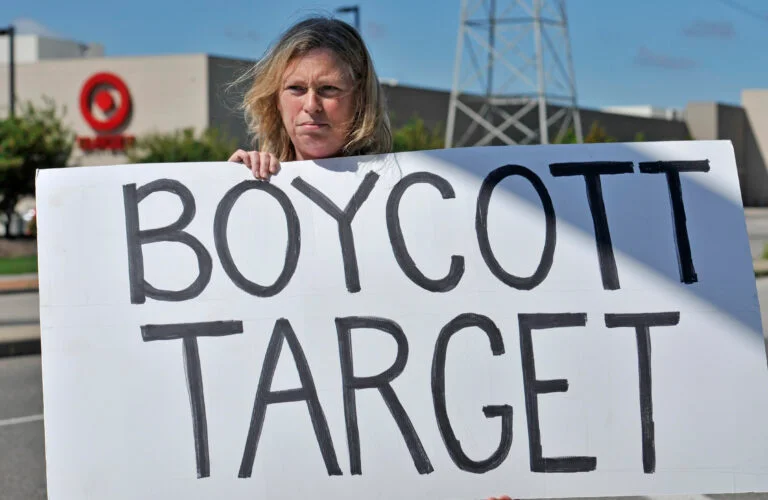
Laura Hedlund protests in front of a Target store. AP Photo/Craig Lassig
On February 28, 2025, the People’s Union USA unveiled a sweeping “economic blackout,” a meticulously planned boycott intended to challenge the dominance of large corporations and spotlight what organizers characterize as spiraling corporate greed. Fronted by spokesperson John Schwarz, this campaign called on Americans to cease spending at major retailers, gas stations, banks, and fast-food outlets for a full 24 hours. Instead, participants were encouraged to patronize small businesses and conduct their transactions in cash, reducing dependence on major financial institutions. According to the movement’s leaders, this one-day boycott is meant to underscore the powerful influence consumers can wield when they act in unison.
Advocates of the economic blackout maintain that the initiative’s significance is straightforward. By targeting corporate profits, everyday people can send a signal that they have grown weary of lopsided pricing, swollen profit margins, and a yawning gulf between average citizens and the business elite. The People’s Union USA claims that many corporations place shareholder warnings above community well-being, and they view this blackout as a moment for ordinary consumers to push back and demand fairness.
Economists and market analysts are not in full agreement about the potential effectiveness of a one-day boycott. Consumer spending makes up nearly seventy percent of the United States’ gross domestic product, and corporate titans in retail, dining, and other sectors take in billions of dollars in daily revenue. Several experts suggest that while a sudden dip in spending might grab headlines, it is unlikely to inflict lasting disruption. They argue that shoppers could simply delay purchases by a day or make them later in the week. A recent report from MarketWatch indicates that similar attempts in the past have led to minor dents in corporate profits, with sales rebounding swiftly once the events concluded.
Still, some point to examples in which more prolonged consumer actions have produced tangible changes. One such instance is the forty-day boycott of Target helmed by Rev. Jamal Bryant, which began earlier in 2025. That campaign protests Target’s decision to reduce certain diversity, equity, and inclusion efforts, seeking instead to direct consumer dollars toward Black-owned businesses. Organizers of this boycott argue that the extended timeframe provides greater bargaining power, putting substantial strain on companies to heed community demands.
In addition to protracted boycotts, alternative methods of consumer advocacy have emerged. The “Carrotmob” movement, for example, flips the script by incentivizing businesses to adopt positive changes. Rather than withholding spending, Carrotmob participants actively reward companies that commit to ethical reforms by increasing patronage. This method—rooted in positive reinforcement—contrasts sharply with the more punitive posture of conventional boycotts. It has spurred strides in sustainability and labor rights at certain local establishments.
A further strategy, sometimes referred to as “gentle protest,” has gained ground through organizations like the Craftivist Collective. This approach highlights peaceful, creative forms of demonstration that foster contemplation rather than conflict. Gentle protest campaigns often involve activities such as mailing handmade messages to corporate executives or quietly assembling in ways that invite dialogue. Proponents believe this less confrontational style promotes enduring engagement and makes it easier to unite various groups that might otherwise remain divided by harsher protest tactics.
In 2024, boycotts targeting corporations associated with deforestation and fossil fuel growth mobilized millions of individuals worldwide. An Associated Press report from that year noted that continued consumer pressure prompted stricter supply chain sustainability protocols at some major food companies. Many activists assert that these developments affirm how coordinated, persistent consumer movements can compel businesses to alter their practices.
Nonetheless, observers wonder whether short-lived economic blackouts can achieve comparable outcomes. Critics argue that although these events receive publicity and raise awareness, they may fizzle without definitive objectives and follow-up campaigns. Some analysts contend that boycotts should be woven into a larger plan featuring negotiations with corporate leaders, efforts for regulatory reform, and robust grassroots organizing.
The People’s Union USA’s economic blackout aspires to harness consumer power and broadcast a unifying statement about equitable pricing and corporate accountability. While it remains uncertain how deeply a one-day demonstration can permeate deeply entrenched business habits, this effort shines a spotlight on mounting exasperation among consumers who feel sidelined by climbing costs and unchecked corporate expansion. As consumer activism continues to broaden, approaches like extended boycotts, Carrotmobs, and gentle protests may serve as complementary tactics aimed at promoting durable social and economic reform. Whether these methods will recalibrate corporate priorities on a larger scale is still an open question, but their growing popularity suggests the dawn of a new era in consumer-led advocacy.
